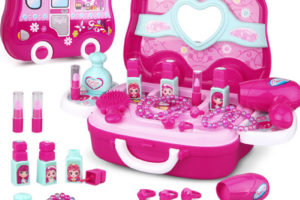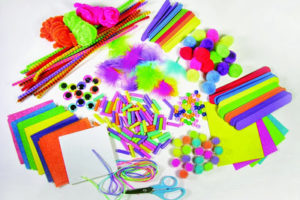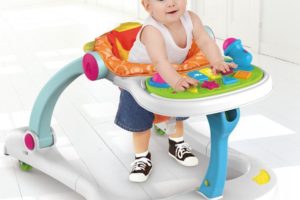Image: Shutterstock
Babies display greater interest in exploring their surroundings as they grow older. They may use different techniques to move around before they begin to walk. Some may roll, crawl, or slither. Scooting is one such technique that some babies adopt to move around.
Scooting may often coincide with crawling or occur independently. But is it okay to scoot? This post provides the necessary information about baby scooting and tips to help babies crawl instead.
What Is Scooting?
Scooting is a mobility technique that a baby may use to move around unassisted (1). It is an alternative to traditional crawling. Unlike standard crawling styles, scooting does not always employ both hands and legs. Some infants combine different styles of movements (2).
There are different types of scooting.
- Bottom scooting: Babies sit on their bottoms and move forward or backward with the help of their arms.
- Sideways scooting: It is also called a crab crawl. Infants move sideways, pushing themselves with their hands and darting like a crab.
- Belly crawling: This style involves the baby scooting on the belly. Babies lie on their stomachs, with feet on the floor, and scoot forward using their arms. They drag their tummy across the ground while moving forward or backward. It is also called a commando crawl.
- Rolling: Babies who use this technique move around to different locations by rolling around the floor. They use their hands to push and move their body.
When Do Babies Start Scooting?
Scooting may often occur around the time when the baby begins crawling. A baby may begin crawling as early as six months and may display scooting at this age (3). Most babies display scooting between the ages of eight and 12 months, with the average age being nine months (4).
Initially, the baby may sway or rock forward and backward on their hands and knees (5). They might even propel themselves in a direction due to greater strength in their arm muscles. The baby will gradually learn to scoot through trial and error and practice.
Is Scooting Bad For Babies?
Scooting is a normal form of movement and not bad for babies. Some infants may entirely rely on alternative methods of movement, such as scooting. According to the American Academy of Pediatrics, as long as the baby can coordinate their body movements and uses all their limbs equally, there is no need to be worried (6).
How Long Do Babies Scoot Before They Crawl?
Most babies switch to crawling within weeks of starting scooting. Some babies may crawl later but do so within eight to 12 months of age. A few babies may alternate between scooting and crawling, while some may not crawl at all. Skipping crawling and relying entirely on scooting is a normal event as long as the baby is achieving other developmental milestones on time.
When To Be Concerned?
Scooting is seldom a cause for concern. However, you may consult a doctor in the following scenarios.
- Some experts note that babies who prefer scooting and skip crawling may not support their body weight on their legs readily (7). They may fold their legs at their knees when held in a standing position. It may cause them to walk later than usual eventually. See a doctor if the baby does not stand when supported at 12 months and does not walk by 18 months (8).
- The baby shows poor coordination between limbs and awkward body movements while scooting or crawling.
- The baby only prefers scooting and has low muscle tone (hypotonia), and seems floppy while moving or when held. In rare cases, it could be indicative of an underlying neuromuscular disorder (9).
- You suspect or observe other physical, cognitive, or speech-related developmental delays in babies.
Precautions To Take When Baby Scoots
A baby who is scooting on the floor is often in a hurry to explore their surroundings. It might lead to mishaps if you do not baby-proof your house. Here are a few precautions to prevent accidents when your baby scoots (10).
- Invest in safety latches and locks: Cabinets and drawers across the house should have safety latches and locks. It can prevent access to potentially harmful substances, such as detergents, cleaners, cosmetics, bleach, or medicines. Kitchen items, such as glassware, sharp objects, or matchsticks, should also be stored locked away from the scooting baby.
- Use doorknob covers and door locks: Door locks are important to deter babies from entering rooms or areas where they can be injured. The locks must be child-proof. Doorknob covers prevent babies from opening doors to potentially risky areas, such as bathrooms, or getting locked in accidentally.
- Secure appliances and furniture: Babies tend to climb over furniture or reach out for appliances placed on furniture. Unattached furniture and appliances, such as television sets, bookcases, or dressers, may tumble down. Anchor such objects to the wall or the floor to prevent them from tipping over. Anti-tip brackets can be used to secure freestanding objects.
- Install window grills: Add window grills or bars to windows and balconies. The installation should be secure, and the gap between the bars should not be more than four inches. Maintain an escape route in every room in case of fire.
- Restrict access to the pool: If you have a pool, install a pool fence around it. Make sure the fence is sturdy enough not to fall even if the baby stands holding to it.
- Use cordless window coverings: Window cords can be hazardous for babies who scoot and explore the house. Use cordless window coverings or tuck the cords away beyond the baby’s reach.
- Remove sharp-edged furniture or cover it: A scooting baby might bang against sharp-edged furniture, leading to injuries. Keep sharp-edged furniture away or cover the edges with protective padding.
- Cover electrical sockets: Babies may touch or insert fingers into electrical sockets. Therefore, use outlet covers or plates to avoid any mishaps.
- Install safety gates: Install safety gates at potentially risky places, such as before a flight of stairs. Make sure you pick gates that meet high safety standards.
How To Help Baby Go From Scooting To Crawling?
Parents may try the following tactics and measures to condition the baby’s body for crawling. These methods may encourage the baby to prefer crawling over scooting eventually (5) (6).
- Initiate tummy time: Put down your baby on the tummy regularly. Tummy time improves a baby’s motor skills and helps strengthen their back and neck muscles, preparing their body for crawling.
- Entice them with interesting toys: Place toys on either side of the baby during tummy time. It will encourage the little one to twist and reach out for the toys. Twisting could help the baby exercise weight transfer and improve their body balance.
- Set some obstacles on their way: Place simple obstacles, such as pillows or boxes, to encourage the baby to try alternative ways of movement. For instance, a scooting baby may have to get down on all fours to crawl over the obstacles. A toy or a parent at the other end of the obstacle course could encourage the baby.
- Hold them horizontal to the ground: Hold the baby face down and horizontal to the ground such that your hands support their torso. Gently move the baby closer to the floor. It will encourage the baby to extend their hands and legs and touch the ground. As your baby gets better at it, you can leave your support, causing the baby to support their torso on their four limbs. It makes for an excellent precursor to crawling.
- Show them how to crawl: Some babies may be motivated to perform an action if they see their parents doing it. You can get on all fours and crawl around your baby while encouraging them to do the same.
Exploring the surroundings by scooting, crawling, or any other style is important for the baby’s overall development. While most babies crawl, it is not uncommon for some to prefer scooting instead. Most babies switch to crawling eventually. If you sense your baby’s scooting might be due to an underlying issue, do not hesitate to take a pediatrician’s opinion.


































